by Jason Bodner
November 19, 2024
“It’s the most wonderful time of the year.”
– Andy Williams’ hit Christmas song from December 1962
“It’s a good time for stocks.”
That’s what I said at a lunch meeting last Thursday, as the market was correcting. Some things in life are obvious. For instance, a giraffe is 30 times more likely to get hit by lightning than a human, being so tall. Or here’s another one: Wearing a necktie can reduce the flow of blood to a fellow’s brain by 7.5%.
Politicians seem to wear a lot of ties… no comment.
November 5th’s red sweep politically certainly elicited a huge chorus of both cheers and jeers. But I’m not into politics. I am into investing. And as an investor, there is plenty to cheer about. The “Trump 2.0 Trade” arrived on cue, and it exploded, but many wonder now, however, if it’s already over.
I have heard no shortage of pundits and pontificators saying the correction will come, if it hasn’t already started. And sure enough, stocks have seen a couple of sloppy days. It is enough to shake confidence.
Those who regularly read my column know that I don’t fall for emotional doubt and anxiety. I prefer cold hard data to guide me in market analysis, so today I will present some evidence that should make you want to get up and dance regardless of who you voted for.
First let’s go over the state of the market. Since election day, unusually large buying has exploded. Below we see the buying distributed by market cap (size). You can see two things clearly:
- There was huge buying – 1,562 unusually large buys to be exact (including ETFs). That works out to 195 large buys per day. The 10-year average daily large buy is 64, and the 34-year average since 1990 is 50. So, since the election buying has been almost four times the multi-decade average.
- When looking at the chart below, we see that 83% of all unusual buying took place in small and mid-sized companies – those with $50 billion market cap and below:
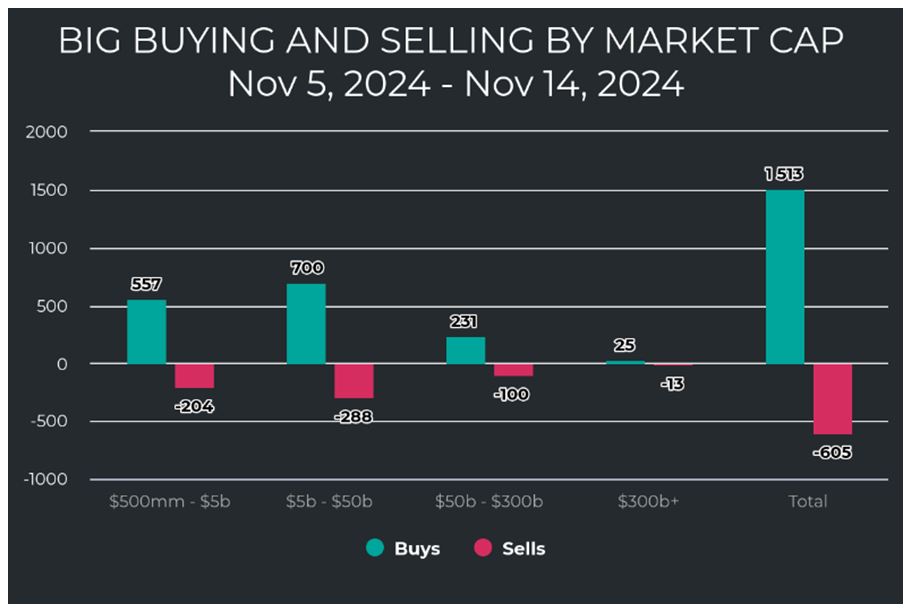
Graphs are for illustrative and discussion purposes only. Please read important disclosures at the end of this commentary.
Next, let’s have a look at trading volumes and how buying shakes out versus the last year.
In the chart on the left, we see that the unusually large trading volumes the day after the election were the highest since last December. The same goes for unusual buys – they were off the charts:
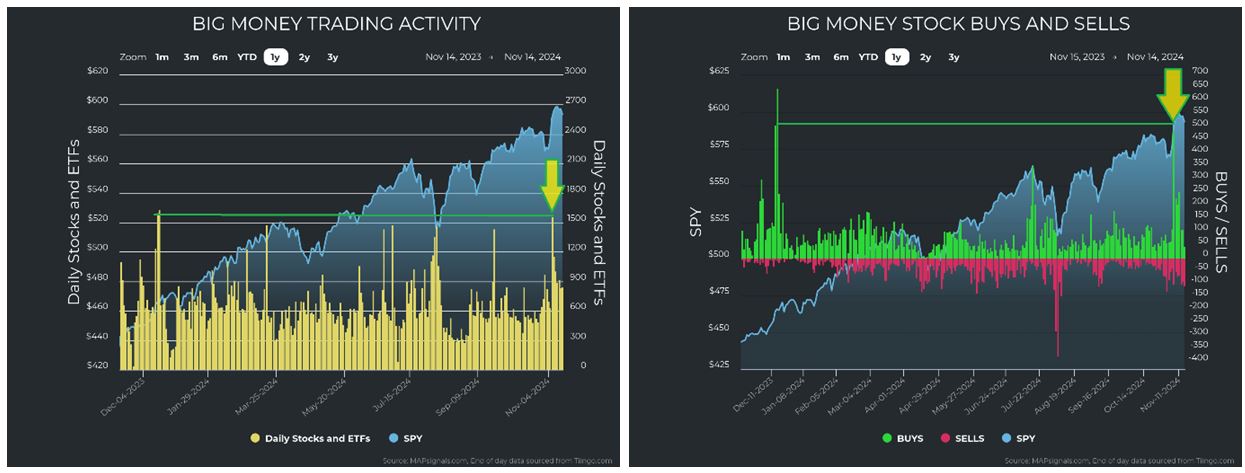
Graphs are for illustrative and discussion purposes only. Please read important disclosures at the end of this commentary.
This might cause you to think that the Big Money Index would shoot higher. As it turns out though, the BMI is falling. That is largely due to four days of abnormal buying momentarily skewing the ratio higher. But as we can see, since October 21st, the ratio hasn’t been overwhelmingly strong:

Graphs are for illustrative and discussion purposes only. Please read important disclosures at the end of this commentary.
This is causing the BMI to drift casually lower:
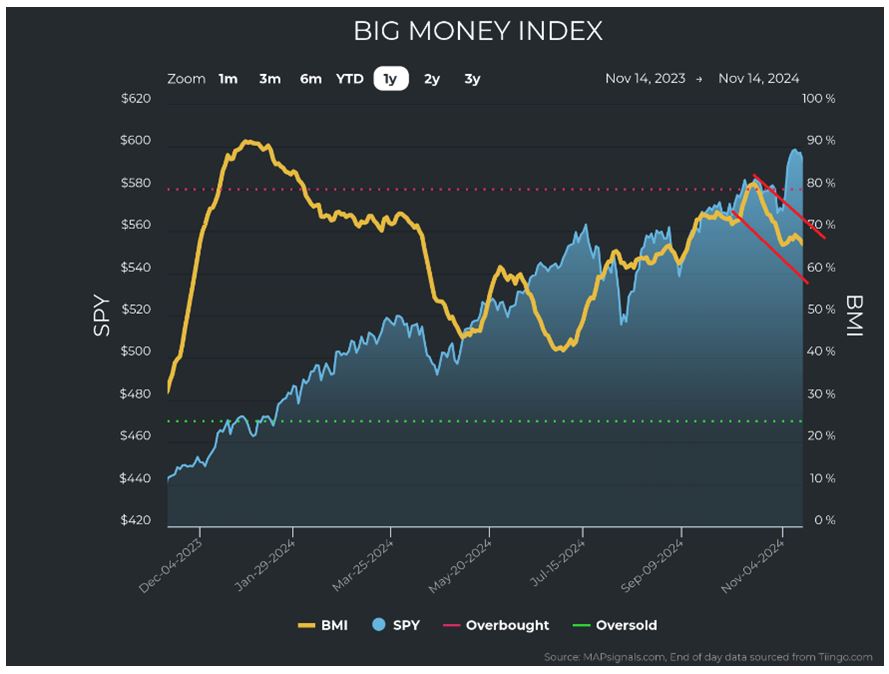
Graphs are for illustrative and discussion purposes only. Please read important disclosures at the end of this commentary.
This might cause some concern along with softer markets since the initial exuberance, so let’s check in on the health and ranks of the sectors to see if we can glean some more information.
The first thing to note is that Financials are exploding higher. With the possibility of less regulation and more M&A, along with higher than average rates, banks stand to do well:
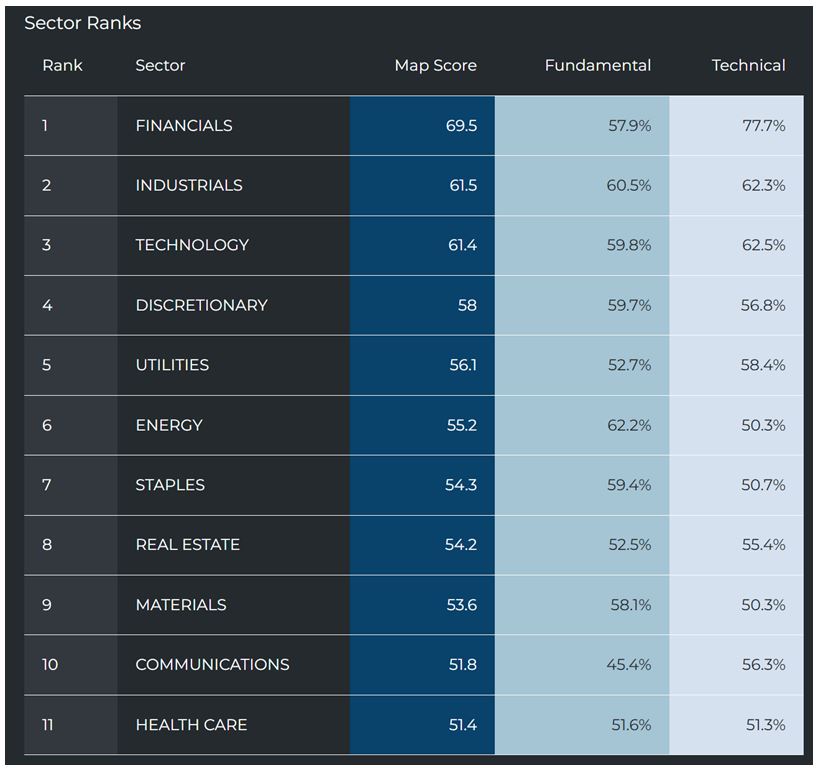
Graphs are for illustrative and discussion purposes only. Please read important disclosures at the end of this commentary.
We also see that Industrials, Technology, and Discretionary sectors round out the top four (of 11). This is bullish, as these growth sectors are the engines of longer-term bull markets. They represent a robust and growing economy with infrastructure projects, technological advancement and a strong consumer.
When we look at buying and selling on a sector level, we see mostly strong indicators. The parabolic buying of Financials was brief, but there is no selling to speak of. The same goes for Industrials, Technology, and Discretionary stocks:



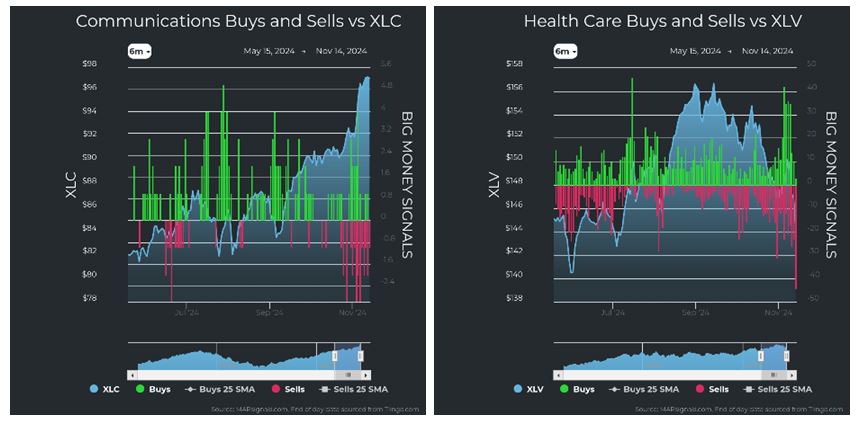
Graphs are for illustrative and discussion purposes only. Please read important disclosures at the end of this commentary.
The only signs of selling are Staples, Materials, and Health Care. Overall, sectors are strong, and we see more buying than selling, so despite a falling BMI and fading market, under the hood – things look fine.
OK, so we have mixed messages. First, we saw big buying, which launched stocks higher. Now they are fading, and we see some spots of weakness. What should we make of all this?
First off, here’s my 100th reminder that we are in the seasonally strongest time of year. November, in particular, since 1990, is the strongest month of the year, up an average 2.82% across all indexes:
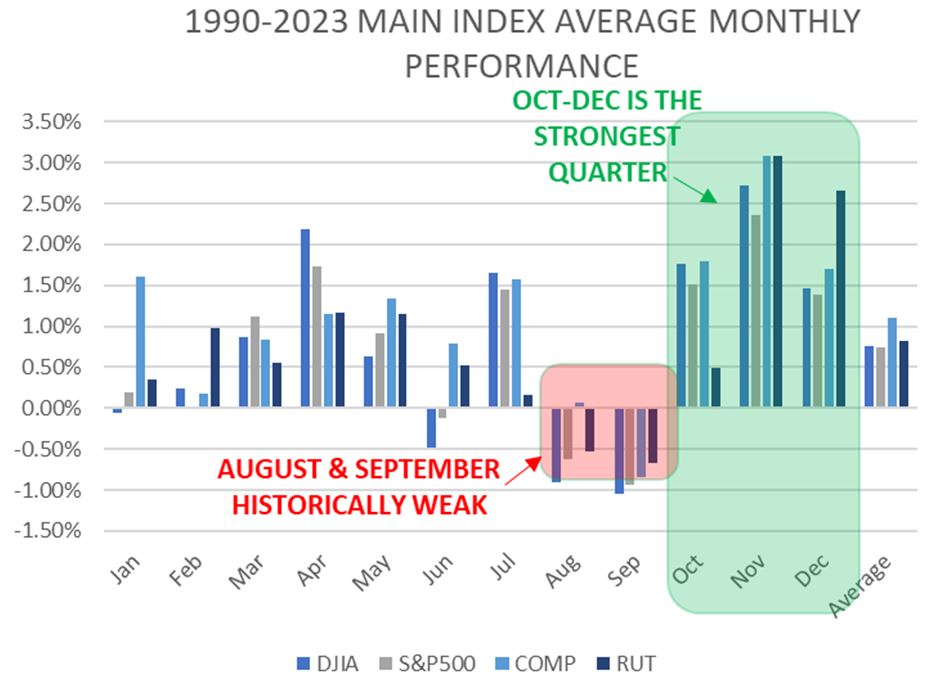
Graphs are for illustrative and discussion purposes only. Please read important disclosures at the end of this commentary.

Graphs are for illustrative and discussion purposes only. Please read important disclosures at the end of this commentary.
Also, the fourth quarter is the strongest quarter, followed by the first quarter, January – March. April is also a seasonally strong month, so we are beginning the market’s strongest six-month stretch, November through April, providing major seasonal tailwinds.
Let’s not forget we also have falling interest rates too, and a business- and tax-friendly administration coming. These are additional tailwinds for stocks.
But what about that fading rally? Is the Trump 2.0 trade all over – in four or five days? Well, let’s look deeper than daily totals. Let’s examine the explosive buying and see what it may hold for the future.
For seven consecutive days, unusual buys were over 100:

Graphs are for illustrative and discussion purposes only. Please read important disclosures at the end of this commentary.
The average worked out to over 200 unusual buys per day. I wanted to look at similar times in history when this happened. I found 31 times prior, spanning 2009 to 2023. The forward returns on average for these times was very strong, and they were positive a vast majority of the time:

Graphs are for illustrative and discussion purposes only. Please read important disclosures at the end of this commentary.
As exciting as that was to see, there is also a problem: Volumes have been steadily increasing since 1990, when my data set begins, so I had to normalize the buying to find similar setups prior to 2009 (remember that huge post-2008 rally?). I found that the seven strong buy days in November accounted for 10% of the buys for the prior trading months (I used 20 trading days – about four weeks).
I looked for similar times and found many more instances. There were 414 prior times like these, and they spanned a much broader time frame. In fact, the only four (of 34) years this didn’t happen.
The forward returns after six months to two years were just shocking:

Graphs are for illustrative and discussion purposes only. Please read important disclosures at the end of this commentary.
To me, this data signals that we should use any dips as a buying opportunity, so don’t listen to the negative crowd; listen to the positive data. It tells us to be excited about stocks.
Max Lucado said: “A man who wants to lead the orchestra must turn his back on the crowd.”
All content above represents the opinion of Jason Bodner of Navellier & Associates, Inc.
Also In This Issue
A Look Ahead by Louis Navellier
“Drill, Baby, Drill” Should Trump Europe’s Green Failures and COP 29
Income Mail by Bryan Perry
The Pause That Refreshes – Before the Year End Rally
Growth Mail by Gary Alexander
What to Expect from Markets (and Swamp Creatures) in 2025
Global Mail by Ivan Martchev
Something Else is Worrying the Market
Sector Spotlight by Jason Bodner
We’re Entering the Best Season for Stocks
View Full Archive
Read Past Issues Here

Jason Bodner
MARKETMAIL EDITOR FOR SECTOR SPOTLIGHT
Jason Bodner writes Sector Spotlight in the weekly Marketmail publication and has authored several white papers for the company. He is also Co-Founder of Macro Analytics for Professionals which produces proprietary equity accumulation and distribution research for its clients. Previously, Mr. Bodner served as Director of European Equity Derivatives for Cantor Fitzgerald Europe in London, then moved to the role of Head of Equity Derivatives North America for the same company in New York. He also served as S.V.P. Equity Derivatives for Jefferies, LLC. He received a B.S. in business administration in 1996, with honors, from Skidmore College as a member of the Periclean Honors Society. All content of “Sector Spotlight” represents the opinion of Jason Bodner
Important Disclosures:
Jason Bodner is a co-founder and co-owner of Mapsignals. Mr. Bodner is an independent contractor who is occasionally hired by Navellier & Associates to write an article and or provide opinions for possible use in articles that appear in Navellier & Associates weekly Market Mail. Mr. Bodner is not employed or affiliated with Louis Navellier, Navellier & Associates, Inc., or any other Navellier owned entity. The opinions and statements made here are those of Mr. Bodner and not necessarily those of any other persons or entities. This is not an endorsement, or solicitation or testimonial or investment advice regarding the BMI Index or any statements or recommendations or analysis in the article or the BMI Index or Mapsignals or its products or strategies.
Although information in these reports has been obtained from and is based upon sources that Navellier believes to be reliable, Navellier does not guarantee its accuracy and it may be incomplete or condensed. All opinions and estimates constitute Navellier’s judgment as of the date the report was created and are subject to change without notice. These reports are for informational purposes only and are not a solicitation for the purchase or sale of a security. Any decision to purchase securities mentioned in these reports must take into account existing public information on such securities or any registered prospectus.To the extent permitted by law, neither Navellier & Associates, Inc., nor any of its affiliates, agents, or service providers assumes any liability or responsibility nor owes any duty of care for any consequences of any person acting or refraining to act in reliance on the information contained in this communication or for any decision based on it.
Past performance is no indication of future results. Investment in securities involves significant risk and has the potential for partial or complete loss of funds invested. It should not be assumed that any securities recommendations made by Navellier. in the future will be profitable or equal the performance of securities made in this report. Dividend payments are not guaranteed. The amount of a dividend payment, if any, can vary over time and issuers may reduce dividends paid on securities in the event of a recession or adverse event affecting a specific industry or issuer.
None of the stock information, data, and company information presented herein constitutes a recommendation by Navellier or a solicitation to buy or sell any securities. Any specific securities identified and described do not represent all of the securities purchased, sold, or recommended for advisory clients. The holdings identified do not represent all of the securities purchased, sold, or recommended for advisory clients and the reader should not assume that investments in the securities identified and discussed were or will be profitable.
Information presented is general information that does not take into account your individual circumstances, financial situation, or needs, nor does it present a personalized recommendation to you. Individual stocks presented may not be suitable for every investor. Investment in securities involves significant risk and has the potential for partial or complete loss of funds invested. Investment in fixed income securities has the potential for the investment return and principal value of an investment to fluctuate so that an investor’s holdings, when redeemed, may be worth less than their original cost.
One cannot invest directly in an index. Index is unmanaged and index performance does not reflect deduction of fees, expenses, or taxes. Presentation of Index data does not reflect a belief by Navellier that any stock index constitutes an investment alternative to any Navellier equity strategy or is necessarily comparable to such strategies. Among the most important differences between the Indices and Navellier strategies are that the Navellier equity strategies may (1) incur material management fees, (2) concentrate its investments in relatively few stocks, industries, or sectors, (3) have significantly greater trading activity and related costs, and (4) be significantly more or less volatile than the Indices.
ETF Risk: We may invest in exchange traded funds (“ETFs”) and some of our investment strategies are generally fully invested in ETFs. Like traditional mutual funds, ETFs charge asset-based fees, but they generally do not charge initial sales charges or redemption fees and investors typically pay only customary brokerage fees to buy and sell ETF shares. The fees and costs charged by ETFs held in client accounts will not be deducted from the compensation the client pays Navellier. ETF prices can fluctuate up or down, and a client account could lose money investing in an ETF if the prices of the securities owned by the ETF go down. ETFs are subject to additional risks:
- ETF shares may trade above or below their net asset value;
- An active trading market for an ETF’s shares may not develop or be maintained;
- The value of an ETF may be more volatile than the underlying portfolio of securities the ETF is designed to track;
- The cost of owning shares of the ETF may exceed those a client would incur by directly investing in the underlying securities and;
- Trading of an ETF’s shares may be halted if the listing exchange’s officials deem it appropriate, the shares are delisted from the exchange, or the activation of market-wide “circuit breakers” (which are tied to large decreases in stock prices) halts stock trading generally.
Grader Disclosures: Investment in equity strategies involves substantial risk and has the potential for partial or complete loss of funds invested. The sample portfolio and any accompanying charts are for informational purposes only and are not to be construed as a solicitation to buy or sell any financial instrument and should not be relied upon as the sole factor in an investment making decision. As a matter of normal and important disclosures to you, as a potential investor, please consider the following: The performance presented is not based on any actual securities trading, portfolio, or accounts, and the reported performance of the A, B, C, D, and F portfolios (collectively the “model portfolios”) should be considered mere “paper” or pro forma performance results based on Navellier’s research.
Investors evaluating any of Navellier & Associates, Inc.’s, (or its affiliates’) Investment Products must not use any information presented here, including the performance figures of the model portfolios, in their evaluation of any Navellier Investment Products. Navellier Investment Products include the firm’s mutual funds and managed accounts. The model portfolios, charts, and other information presented do not represent actual funded trades and are not actual funded portfolios. There are material differences between Navellier Investment Products’ portfolios and the model portfolios, research, and performance figures presented here. The model portfolios and the research results (1) may contain stocks or ETFs that are illiquid and difficult to trade; (2) may contain stock or ETF holdings materially different from actual funded Navellier Investment Product portfolios; (3) include the reinvestment of all dividends and other earnings, estimated trading costs, commissions, or management fees; and, (4) may not reflect prices obtained in an actual funded Navellier Investment Product portfolio. For these and other reasons, the reported performances of model portfolios do not reflect the performance results of Navellier’s actually funded and traded Investment Products. In most cases, Navellier’s Investment Products have materially lower performance results than the performances of the model portfolios presented.
This report contains statements that are, or may be considered to be, forward-looking statements. All statements that are not historical facts, including statements about our beliefs or expectations, are “forward-looking statements” within the meaning of The U.S. Private Securities Litigation Reform Act of 1995. These statements may be identified by such forward-looking terminology as “expect,” “estimate,” “plan,” “intend,” “believe,” “anticipate,” “may,” “will,” “should,” “could,” “continue,” “project,” or similar statements or variations of such terms. Our forward-looking statements are based on a series of expectations, assumptions, and projections, are not guarantees of future results or performance, and involve substantial risks and uncertainty as described in Form ADV Part 2A of our filing with the Securities and Exchange Commission (SEC), which is available at www.adviserinfo.sec.gov or by requesting a copy by emailing info@navellier.com. All of our forward-looking statements are as of the date of this report only. We can give no assurance that such expectations or forward-looking statements will prove to be correct. Actual results may differ materially. You are urged to carefully consider all such factors.
FEDERAL TAX ADVICE DISCLAIMER: As required by U.S. Treasury Regulations, you are informed that, to the extent this presentation includes any federal tax advice, the presentation is not written by Navellier to be used, and cannot be used, for the purpose of avoiding federal tax penalties. Navellier does not advise on any income tax requirements or issues. Use of any information presented by Navellier is for general information only and does not represent tax advice either express or implied. You are encouraged to seek professional tax advice for income tax questions and assistance.
IMPORTANT NEWSLETTER DISCLOSURE:The hypothetical performance results for investment newsletters that are authored or edited by Louis Navellier, including Louis Navellier’s Growth Investor, Louis Navellier’s Breakthrough Stocks, Louis Navellier’s Accelerated Profits, and Louis Navellier’s Platinum Club, are not based on any actual securities trading, portfolio, or accounts, and the newsletters’ reported hypothetical performances should be considered mere “paper” or proforma hypothetical performance results and are not actual performance of real world trades. Navellier & Associates, Inc. does not have any relation to or affiliation with the owner of these newsletters. There are material differences between Navellier Investment Products’ portfolios and the InvestorPlace Media, LLC newsletter portfolios authored by Louis Navellier. The InvestorPlace Media, LLC newsletters contain hypothetical performance that do not include transaction costs, advisory fees, or other fees a client might incur if actual investments and trades were being made by an investor. As a result, newsletter performance should not be used to evaluate Navellier Investment services which are separate and different from the newsletters. The owner of the newsletters is InvestorPlace Media, LLC and any questions concerning the newsletters, including any newsletter advertising or hypothetical Newsletter performance claims, (which are calculated solely by Investor Place Media and not Navellier) should be referred to InvestorPlace Media, LLC at (800) 718-8289.
Please note that Navellier & Associates and the Navellier Private Client Group are managed completely independent of the newsletters owned and published by InvestorPlace Media, LLC and written and edited by Louis Navellier, and investment performance of the newsletters should in no way be considered indicative of potential future investment performance for any Navellier & Associates separately managed account portfolio. Potential investors should consult with their financial advisor before investing in any Navellier Investment Product.
Navellier claims compliance with Global Investment Performance Standards (GIPS). To receive a complete list and descriptions of Navellier’s composites and/or a presentation that adheres to the GIPS standards, please contact Navellier or click here. It should not be assumed that any securities recommendations made by Navellier & Associates, Inc. in the future will be profitable or equal the performance of securities made in this report.
FactSet Disclosure: Navellier does not independently calculate the statistical information included in the attached report. The calculation and the information are provided by FactSet, a company not related to Navellier. Although information contained in the report has been obtained from FactSet and is based on sources Navellier believes to be reliable, Navellier does not guarantee its accuracy, and it may be incomplete or condensed. The report and the related FactSet sourced information are provided on an “as is” basis. The user assumes the entire risk of any use made of this information. Investors should consider the report as only a single factor in making their investment decision. The report is for informational purposes only and is not intended as an offer or solicitation for the purchase or sale of a security. FactSet sourced information is the exclusive property of FactSet. Without prior written permission of FactSet, this information may not be reproduced, disseminated or used to create any financial products. All indices are unmanaged and performance of the indices include reinvestment of dividends and interest income, unless otherwise noted, are not illustrative of any particular investment and an investment cannot be made in any index. Past performance is no guarantee of future results.
